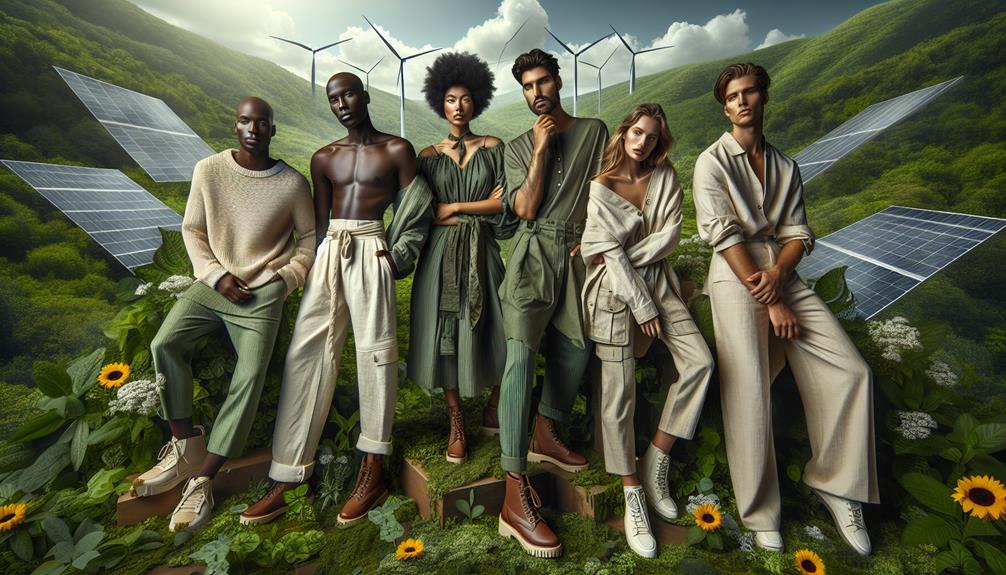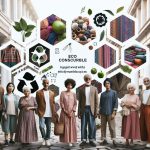Imagine a closet filled with garments crafted from recycled plastics, organic cotton, and biodegradable textiles, each piece telling a story of innovation and care for the planet. You've likely heard about eco-friendly fashion brands, but do you know how they're setting new industry standards? These brands are not just about using sustainable materials; they're also committed to ethical labor practices and transparent supply chains. Their efforts in minimizing waste and reducing carbon emissions are impressive, but what truly sets them apart? Discover how these pioneers are transforming the fashion landscape and inspiring a more sustainable future.
Table of Contents
Key Takeaways
- Brands use innovative materials like recycled plastics and organic cotton to create eco-friendly fashion.
- Companies adopt biodegradable textiles and plant-based fibers such as hemp and bamboo.
- Labels prioritize transparent supply chains to ensure products have eco-friendly certifications.
- Fashion houses embrace upcycled designs, turning waste materials into stylish garments.
- Firms invest in sustainable practices to lower carbon emissions and use renewable energy sources.
Innovative Materials
Brands are revolutionizing eco-friendly fashion by using innovative materials like recycled plastics and organic cotton. You're probably seeing more of these options in your favorite stores. But have you ever wondered what makes these materials so special?
Take biodegradable textiles, for instance. These fabrics break down naturally, reducing waste and pollution. Imagine a shirt that returns to the earth without harming it—it's a game-changer for fashion sustainability.
Plant-based fashion is another groundbreaking trend. By leveraging materials derived from plants, brands create clothing that's not only stylish but also eco-conscious. Think of garments made from hemp, bamboo, or even pineapple fibers. These options aren't just sustainable; they're also incredibly versatile and durable.
When you choose pieces made from these innovative materials, you're not just buying clothes; you're investing in the planet's future. It's a way to showcase your commitment to sustainability while enjoying products that are crafted with ingenuity and care.
Ethical Labor Practices
When you choose eco-friendly fashion brands, you're supporting fair wages and safe working conditions for workers.
These brands guarantee their labor practices empower communities and promote sustainability.
It's not just about the clothes; it's about making a positive impact on people's lives.
Fair Wages Guaranteed
Ensuring fair wages and ethical labor practices means that workers are treated with respect and paid what they deserve. When you support brands that guarantee fair wages, you're advocating for sustainable employment and ethical compensation. It's essential to recognize that fair wages are a cornerstone of worker rights and social responsibility, ensuring that laborers are not exploited.
Here's a quick overview of what fair wage practices entail:
| Aspect | Definition | Impact |
|---|---|---|
| Ethical Compensation | Payment that reflects the true value of labor | Promotes economic stability |
| Sustainable Employment | Long-term job security for workers | Reduces poverty and inequality |
| Worker Rights | Ensuring fair treatment and wages | Enhances worker morale and loyalty |
| Social Responsibility | Corporate commitment to fair labor practices | Builds brand trust and reputation |
Safe Working Conditions
While fair wages are essential, ensuring safe working conditions is equally significant for ethical labor practices. You need to recognize that worker safety directly impacts the overall sustainability of any fashion brand. When workers operate in safe environments, their health is preserved, leading to higher productivity and lower turnover rates. This, in turn, reduces the environmental impact associated with high employee replacement costs and training requirements.
By prioritizing worker health, eco-friendly fashion brands are setting an example for the industry. They incorporate stringent safety protocols, ensuring that their manufacturing processes don't expose employees to harmful chemicals or unsafe machinery. This commitment to safe working conditions also extends to proper ventilation systems, ergonomic workspaces, and regular health check-ups.
These measures aren't just about compliance; they're about fostering a sustainable workforce that can thrive without compromising their well-being.
Moreover, sustainable practices in worker safety often lead to innovations that benefit the entire production chain. When you support brands that prioritize these ethical labor practices, you're not just buying a product—you're endorsing a system that values human life and mitigates environmental impact.
Community Empowerment Initiatives
Community empowerment initiatives are crucial for ethical labor practices in sustainable fashion. When you support brands that prioritize these initiatives, you're not just purchasing clothes; you're fostering positive change in local communities. Brands that invest in skill development programs and local partnerships create sustainable livelihoods and promote grassroots empowerment.
Imagine the impact of a brand that collaborates with local artisans to produce high-quality, eco-friendly garments. These initiatives guarantee that artisans receive fair wages and work in safe conditions while preserving their cultural heritage. Skill development programs equip workers with modern techniques, enhancing their craft and expanding their employment opportunities.
Consider the benefits:
| Initiative | Impact on Community | Benefits to Brand |
|---|---|---|
| Skill Development Programs | Enhanced craftsmanship | Higher quality products |
| Local Partnerships | Economic growth | Stronger brand loyalty |
| Sustainable Livelihoods | Financial stability | Ethical brand reputation |
| Grassroots Empowerment | Increased community support | Positive brand image |
Transparent Supply Chains
Transparent supply chains allow you to see exactly where and how your clothes are made, fostering trust and accountability in eco-friendly fashion brands. By providing insight into their processes, these brands guarantee you're investing in products with eco-friendly certifications and ethical sourcing. This transparency helps you make informed decisions, knowing that the materials and labor involved align with your values.
When brands emphasize sustainable production and traceable origins, they set a new standard for the industry. You're able to track each step of the manufacturing process, from the raw materials to the finished product. This ensures that every stage adheres to environmental and ethical guidelines, promoting a culture of responsibility.
Consider the benefits of transparent supply chains:
- Informed Choices: You can choose brands that prioritize eco-friendly certifications, guaranteeing your purchases support sustainable and ethical practices.
- Accountability: Brands are held accountable for their sourcing and production processes, encouraging continuous improvement.
- Consumer Trust: Knowing the origins of your clothes builds trust, making you more likely to support brands committed to transparency.
Recycled Fabrics
Recycled fabrics offer a sustainable alternative by repurposing waste materials into new, stylish garments. By embracing upcycled designs, you're not just adding unique pieces to your wardrobe but also supporting sustainable production. With eco conscious fashion on the rise, designers are turning discarded textiles, plastic bottles, and even old garments into high-quality fabrics. This process not only reduces waste but also conserves resources, aligning perfectly with the principles of a circular economy.
Here's a quick comparison to highlight the benefits of recycled fabrics:
| Traditional Fabrics | Recycled Fabrics | Benefits |
|---|---|---|
| Raw material use | Zero new raw materials | Lowers environmental impact |
| High energy consumption | Reduced energy use | More efficient production |
| Linear economy | Circular economy | Promotes sustainability |
Minimizing Waste
One effective way to minimize waste in fashion is by adopting zero-waste design techniques. These methods guarantee that every scrap of fabric is used, reducing the amount of textile waste that ends up in landfills.
You can also explore upcycling techniques, which breathe new life into old garments and materials, transforming them into fresh, stylish pieces.
To further your commitment to minimizing waste, consider sustainable packaging. Brands that use biodegradable or reusable packaging drastically reduce the environmental footprint left by conventional plastic packaging. This not only aligns with eco-friendly values but also appeals to a consumer base increasingly conscious of sustainability.
Here are three actionable strategies to minimize waste in fashion:
- Zero-Waste Design: Create patterns that utilize the entire fabric, leaving no scraps behind.
- Upcycling Techniques: Convert old clothing and materials into new, high-quality products.
- Sustainable Packaging: Opt for packaging solutions that are biodegradable or reusable to diminish waste.
Reducing Carbon Emissions
Alongside minimizing waste, fashion brands can significantly reduce their environmental impact by focusing on lowering carbon emissions. You can achieve this by implementing sustainable practices throughout the production cycle. From sourcing eco-friendly materials to optimizing logistics, every step matters.
Using renewable energy in manufacturing facilities, for instance, notably cuts down on fossil fuel use. Carbon offsetting is another powerful tool at your disposal. By investing in projects that absorb carbon dioxide, such as reforestation or renewable energy initiatives, you can neutralize your brand's carbon footprint. It's not just about reducing emissions but also compensating for those that are unavoidable.
Additionally, consider redesigning your supply chain to be more efficient. Partner with local suppliers to reduce transportation emissions. Adopt energy-efficient technologies and practices in your stores and offices. These changes might seem small individually, but collectively, they make a substantial difference.
Educating your customers about your sustainable practices is equally important. When people know the steps you're taking to reduce carbon emissions, they're more likely to support your brand. By integrating these strategies, you'll not only help the planet but also position your brand as a leader in eco-friendly fashion.
Frequently Asked Questions
What Are Some Affordable Eco-Friendly Fashion Brands for Budget-Conscious Consumers?
Finding affordable eco-friendly fashion brands can feel like discovering a hidden gem. Brands like Pact and Everlane offer sustainable options without breaking the bank. They emphasize ethical fashion, ensuring you make a positive impact with every purchase.
How Do Eco-Friendly Fashion Brands Ensure Product Durability and Longevity?
You'll find eco-friendly fashion brands ensuring product durability and longevity by prioritizing material sourcing, ethical manufacturing, and sustainable practices. They focus on eco-conscious designs that use high-quality materials and craftsmanship to create lasting apparel.
Are There Any Eco-Friendly Fashion Brands That Offer Plus-Size Clothing?
You'll be thrilled to know that some brands offer mind-blowing plus-size options with inclusive sizing. They combine sustainable practices and ethical production, ensuring you don't have to compromise on style or values.
How Can Consumers Verify the Sustainability Claims of Fashion Brands?
To verify a fashion brand's sustainability claims, you'll need to focus on greenwashing detection and sustainable materials verification. Confirm the brand meets transparency standards and conducts ethical sourcing validation to confirm their authenticity and commitment.
What Role Do Certifications Play in Identifying Eco-Friendly Fashion Brands?
Certifications are your ultimate weapon for identifying truly eco-friendly fashion brands. They scream transparency and guarantee that materials used are genuinely sustainable. Without them, you're just gambling on empty promises. Trust certifications to master eco-conscious shopping.
- Getting Coconut Oil Out of Fabric: Common Mistakes to Avoid - June 29, 2025
- How to Clean Coconut Oil From Any Type of Fabric - June 29, 2025
- What Is Coconut Carbon Fabric and What Is It Used For? - June 29, 2025





